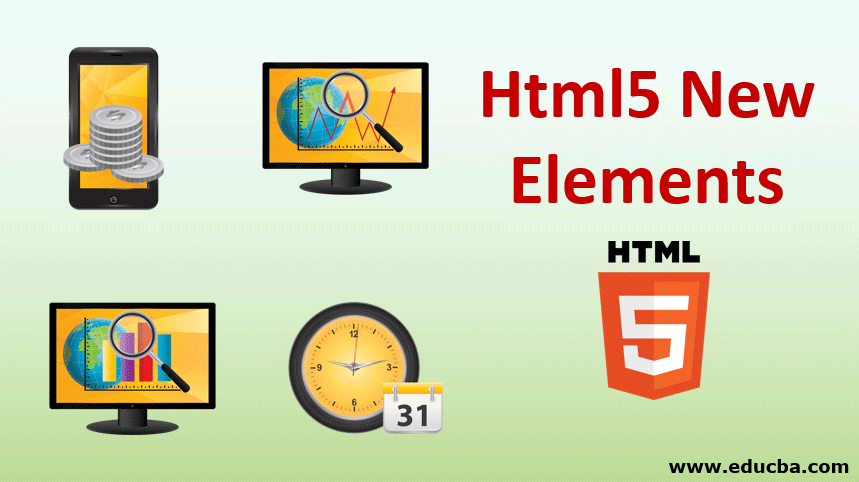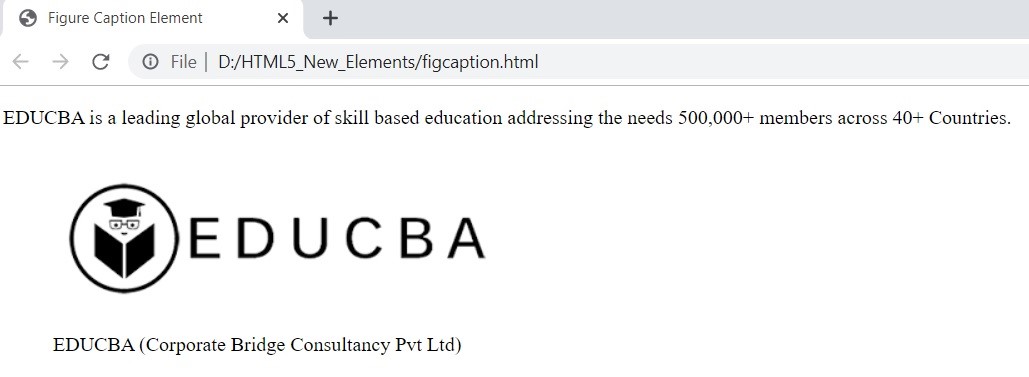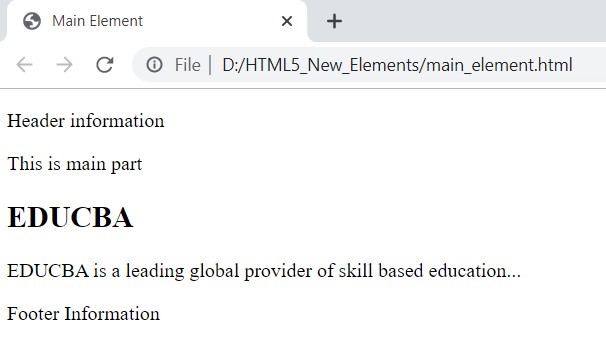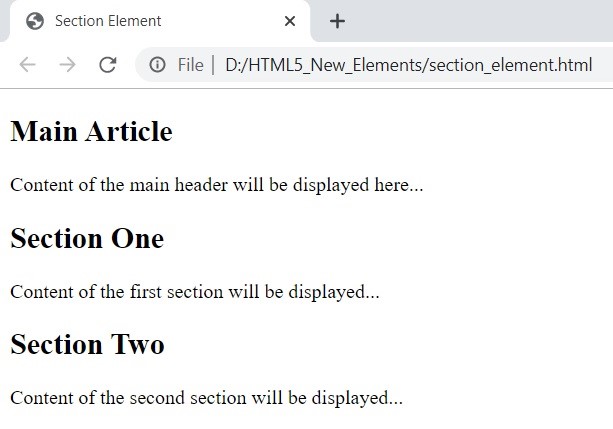Updated July 4, 2023
Overview of HTML5 New Elements
HTML5 is a new upgrade from HTML 4.01 version that has many new features, advanced functional features, better page views, and many other improvements to match the growing technological needs. The most used and desired elements of HTML5 are <figure>, <figcaption>, <article>, <header>, <main>,<mark>,<footer>, <nav>, <section> and <summary>. These tags/ elements of HTML 5 enable far more user-friendly interfaces, with higher performance rates, efficient outcomes, and easier to code and implement, and it helps in improvising the layout as a whole.
Top 10 HTML5 New Elements
HTML5 provides new elements to enhance the layout of the document.
1. <article>
The <article> element specifies a portion of a page that includes a separate structure in a document, section, or website and is recommended to be widely distributed or usable. This may be a group post, a journal or daily paper report, a submission to an online newsletter, a remark sent by a customer, or any other substance-free object.
Example:
<!DOCTYPE html>
<html>
<head>
<title>Article Element</title>
</head>
<body>
<article>
<h2>EDUCBA</h2>
<p>EDUCBA (Corporate Bridge Consultancy Pvt Ltd) is a leading global provider of skill based education addressing the needs 500,000+ members across 40+ Countries. </p>
</article>
</body>
</html>Output:
- Save the above code in a file with a .html extension.
- Run the html file in a browser, and you will get the output shown in the image below.
2. <figure>
The <figure> element indicates individual content, such as categorizations, maps, images, code articles, etc.
Example:
<!DOCTYPE html>
<html>
<head>
<title>Figure Element</title>
</head>
<body>
<p> EDUCBA is a leading global provider of skill based education addressing the needs 500,000+ members across 40+ Countries.
</p>
<figure>
<img src="educba.png"/>
</figure>
</body>
</html>Output:
The above code will produce the output as shown in the below image,
3. <figcaption>
The <figcaption> element adds a description for the image.
Example:
<!DOCTYPE html>
<html>
<head>
<title>Figure Caption Element</title>
</head>
<body>
<p> EDUCBA is a leading global provider of skill based education addressing the needs 500,000+ members across 40+ Countries.
</p>
<figure>
<img src="educba.png"/>
<figcaption>EDUCBA (Corporate Bridge Consultancy Pvt Ltd)</figcaption>
</figure>
</body>
</html>Output:
The above code displays the result as shown in the below image,
4. <header>
The <header> element specifies the header for a document or a section on the page. You can define more than one header in a single document.
Example:
<!DOCTYPE html>
<html>
<head>
<title>Header Element</title>
</head>
<body>
<article>
<header>
<h1>Header One</h1>
<h2>Header Two</h2>
<h3>Header Three</h3>
</header>
<p>The content of the document goes here...</p>
</article>
</body>
</html>Output:
The above code displays the result as shown in the below image,
5. <footer>
The <footer> element specifies information such as author information, copyright information, contact, links to related documents, sitemap, and many more.
Example:
<!DOCTYPE html>
<html>
<head>
<title>Footer Element</title>
</head>
<body>
<footer>
<p>Copyright © 2019 www.educba.com</p>
<p>Contact: <a href="mailto:hr@educba.com">hr@educba.com</a>
</footer>
</body>
</html>Output:
The above code displays the result as shown in the below image,
6. <main>
The <main> element is used for displaying a document’s main, i.e., important information.
Example:
<!DOCTYPE html>
<html>
<head>
<title>Main Element</title>
</head>
<body>
<header>
<p>Header information</>
</header>
<main>
<p>Main Information</p>
<article>
<h2>EDUCBA</h2>
<p>EDUCBA is a leading global provider of skill based education...</p>
</article>
</main>
<footer>
<p>Footer Information</>
</footer>
</body>
</html>Output:
The above code will produce the output as shown in the below image,
7. <mark>
The <mark> element highlights or marks the text with the background color that attracts the user to a particular text on the document.
Example:
<!DOCTYPE html>
<html>
<head>
<title>Mark Element</title>
</head>
<body>
<article>
<p><mark>EDUCBA</mark> is a leading global provider of skill based education addressing the needs 500,000+ members across 40+ Countries. </p>
</article>
</body>
</html>Output:
The above code displays the result as shown in the below image,
8. <nav>
The <nav> element is used to specify the navigational links on the page. These links provide connections to other pages in a document.
Example:
<!DOCTYPE html>
<html>
<head>
<title>Nav Element</title>
</head>
<body>
<header>
<nav>
<a href="#">HTML</a> |
<a href="#">CSS</a> |
<a href="#">JAVA</a> |
<a href="#">PHP</a> |
<a href="#">PYTHON</a>
</nav>
</header>
</body>
</html>Output:
The above code will produce the output as shown in the below image,
9. <section>
The <section> element defines the document’s standalone section or specific region.
Example:
<!DOCTYPE html>
<html>
<head>
<title>Section Element</title>
</head>
<body>
<article>
<h2> Main Article </h2>
<p>Content of the main header will be displayed here...</p>
<section>
<h2>Section One</h2>
<p>Content of the first section will be displayed...</p>
</section>
<section>
<h2>Section Two</h2>
<p>Content of the second section will be displayed...</p>
</section>
</article>
</body>
</html>Output:
The above code displays the result as shown in the below image,
10. <summary>
The <summary> tag is a subpart of the <details> tag which provides the text that can be displayed or hidden when the user clicks the heading.
Example:
<!DOCTYPE html>
<html>
<head>
<title>Summary Element</title>
</head>
<body>
<details>
<summary>
EDUCBA - Corporate Bridge Consultancy Pvt Ltd
</summary>
<p>It is a leading global provider of skill based education addressing the needs 500,000+ members across 40+ Countries.</p>
</details>
</body>
</html>Output:
When you run the above code, it will display the result as shown below,
As shown in the image, click on the heading, and it will display the hidden text shown below the image,
Conclusion
So far, we have seen how new HTML5 elements are useful for various website creation tasks. These new elements read the document in a more accurate & standard way and develop more complex and efficient web apps. The new HTML5 elements give some additional extra features to generate interactive websites.
Recommended Articles
We hope that this EDUCBA information on “Html5 New Elements” was beneficial to you. You can view EDUCBA’s recommended articles for more information,













